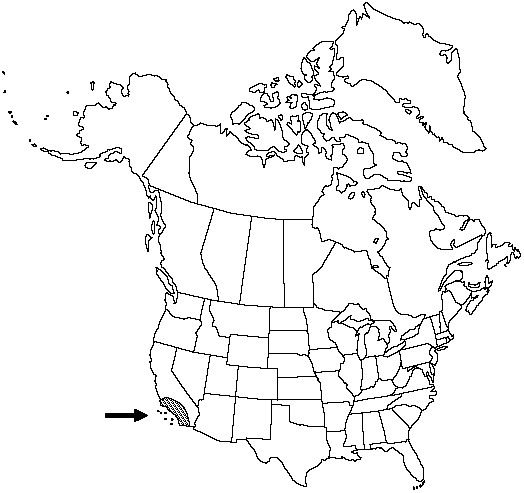Difference between revisions of "Cheilanthes clevelandii"
Bull. Torrey Bot. Club 6: 33. 1875.
FNA>Volume Importer |
FNA>Volume Importer |
||
| Line 24: | Line 24: | ||
|elevation=0–1600 m | |elevation=0–1600 m | ||
|distribution=Calif.;Mexico in Baja;California. | |distribution=Calif.;Mexico in Baja;California. | ||
| − | |discussion=<p>Although some specimens of Cheilanthes clevelandii can be difficult to distinguish from C. covillei and C. intertexta (see comments under C. covillei), the species is restricted to the coastal mountains of California and Baja California, and it rarely overlaps the ranges of these closely related species. In the region where C. clevelandii is sympatric with C. intertexta, the smaller spores of the former species (averaging less that 55 µm in diameter) are helpful in identification. T. Reeves (1979) tentatively identified two varieties of C. clevelandii, but formal recognition of these taxa must await further study.</p> | + | |discussion=<p>Although some specimens of <i>Cheilanthes clevelandii</i> can be difficult to distinguish from <i>C. covillei</i> and <i>C. intertexta</i> (see comments under <i>C. covillei</i>), the species is restricted to the coastal mountains of California and Baja California, and it rarely overlaps the ranges of these closely related species. In the region where <i>C. clevelandii</i> is sympatric with <i>C. intertexta</i>, the smaller spores of the former species (averaging less that 55 µm in diameter) are helpful in identification. T. Reeves (1979) tentatively identified two varieties of <i>C. clevelandii</i>, but formal recognition of these taxa must await further study.</p> |
|tables= | |tables= | ||
|references= | |references= | ||
| Line 48: | Line 48: | ||
|publication year=1875 | |publication year=1875 | ||
|special status= | |special status= | ||
| − | |source xml=https://jpend@bitbucket.org/aafc-mbb/fna-data-curation.git/src/ | + | |source xml=https://jpend@bitbucket.org/aafc-mbb/fna-data-curation.git/src/8f726806613d60c220dc4493de13607dd3150896/coarse_grained_fna_xml/V2/V2_192.xml |
|genus=Cheilanthes | |genus=Cheilanthes | ||
|species=Cheilanthes clevelandii | |species=Cheilanthes clevelandii | ||
Revision as of 15:46, 18 September 2019
Stems usually short-creeping, 1–3 mm diam.; scales usually bicolored, with well-defined, dark, central stripe and broad, light brown margins, lanceolate, straight to slightly contorted, strongly appressed, persistent. Leaves clustered to somewhat scattered, 8–40 cm; vernation noncircinate. Petiole dark to light brown, rounded adaxially. Blade oblong-lanceolate to ovate, usually 4-pinnate at base, 2–8 cm wide; rachis rounded adaxially, with scattered scales and sparse monomorphic pubescence. Pinnae not articulate, dark color of stalk continuing into pinna base, basal pair not conspicuously larger than adjacent pair, usually equilateral, appearing glabrous adaxially. Costae green adaxially for most of length; abaxial scales multiseriate, ovate-lanceolate, deeply cordate at base, with overlapping basal lobes, conspicuous, 0.4–1 mm wide, imbricate, occasionally concealing ultimate segments, ciliate (usually only on proximal 1/2). Ultimate segments round to subcordate, beadlike, the largest 1–2 mm, abaxially with branched hairs and small ciliate scales, adaxially glabrous. False indusia marginal, weakly differentiated, 0.05–0.25 mm wide. Sori ± continuous around segment margins. Sporangia containing 64 spores.
Phenology: Sporulating late spring–summer.
Habitat: Rocky slopes and ledges, usually on igneous substrates
Elevation: 0–1600 m
Distribution

Calif., Mexico in Baja, California.
Discussion
Although some specimens of Cheilanthes clevelandii can be difficult to distinguish from C. covillei and C. intertexta (see comments under C. covillei), the species is restricted to the coastal mountains of California and Baja California, and it rarely overlaps the ranges of these closely related species. In the region where C. clevelandii is sympatric with C. intertexta, the smaller spores of the former species (averaging less that 55 µm in diameter) are helpful in identification. T. Reeves (1979) tentatively identified two varieties of C. clevelandii, but formal recognition of these taxa must await further study.
Selected References
None.